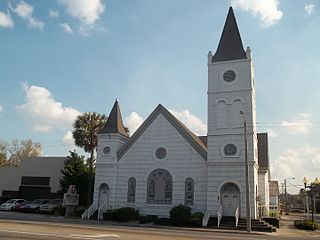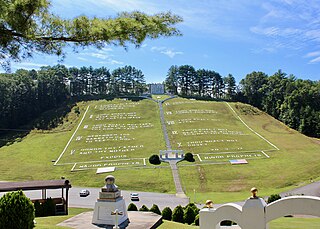| Latter Rain Movement | |
|---|---|
| Classification | Protestant |
| Founder | R. G. Spurling, Sr. |
| Origin | 1886 North Carolina and Tennessee |
The Latter Rain Movement was a late nineteenth-century radical Holiness theology and Revivalist phenomenon which began in western North Carolina and eastern Tennessee. Elements of the movement gave rise to and merged with what would become incipient modern Pentecostalism. [1]
The Latter Rain Movement began in western North Carolina and eastern Tennessee among groups of disaffected Baptists and Methodists. [2] The movement was spread throughout the area by Baptist preacher Richard G. Spurling, Sr., and the use of "Latter Rain" to describe the movement originated at this time. [1] Considerable opposition from other Baptists arose, and a distinctive identity emerged. At a Holiness revival meeting in Monroe County, Tennessee, during 1886 the movement coalesced with the formation of the Christian Union. [3]
Spurling, Sr., was joined by his son Richard G. Spurling Jr, and by Methodist preacher W. F. Bryant. [4]
Spurling, Jr., held a revival in his Baptist church in Liberty, Tennessee, during 1892 during which some members spoke in tongues. This resulted in Spurling's expulsion along with some 30 of the congregation. They began meeting at the home of W. F. Bryant in nearby Camp Creek (Cherokee County, North Carolina). [3] From this, the Holiness Church was organized by Spurling, Bryant and Frank Porter. [5] This church became the organizational hub of the rapidly spreading movement. [4]
Ambrose J. Tomlinson, then a colporteur, came in contact with the Camp Creek Holiness Church in 1896. He accepted it as representing the New Testament pattern, and in 1903 he joined it as a preacher. [6] Spurling, Jr., and William F. Bryant, even though they remained respected figures, gradually gave way to Tomlinson's strong influence. [7]
Tomlinson eventually assumed clear leadership of the movement and began drawing together many of the earlier Latter Rain congregations. [8] In 1906, he held the first annual Assembly of the movement at Camp Creek. The next year he moved it to Union Grove, closer to his home in Cleveland, Tennessee. In 1907, he also changed the name from Holiness Church to The Church of God, [9] and began preaching at revivals nationwide and drawing other congregations to the movement. Similar revivals began taking place at this time, including those at Topeka, Kansas, under Charles Fox Parham, and Azusa Street in Los Angeles under William J. Seymour. [6] [4] [10] Together, these became known as "The Outpouring of the Latter Rain". [6]
In 1908, the headquarters of the Church of God were moved to Cleveland, Tennessee, and in 1909 Tomlinson was elected its General Overseer of the Church of God denomination. Even though Tomlinson had been successful in gathering together many congregations which identified with the Latter Rain Movement, this unity was temporary and schisms began to occur almost immediately. Tomlinson himself was later expelled. [6] [8]
The beliefs held by the group contained variations, depending on time and place. In the early days, the movement saw itself as non-denominational and sought to bring all other denominations under its umbrella to reconstitute a universal Church. Certain shared doctrines have been noted, which include a conviction that the group exhibits a restoration of the primitive pattern followed by the New Testament Church. The group also frequently proclaimed Dispensationalist themes and held to many of the same precepts as the Holiness movement. [11] A doctrine of holiness as being a work arising out of grace, but following justification, seems also to figure in early sermons. [6]
The term "Latter Rain" itself indicates a belief that the Last Days have come upon the world. [11] In accordance to the verses in Joel 2:23-29 [12] in which the term "Latter Rain" occurs, there was a prominent acceptance and encouragement of Spirit baptism, speaking in tongues, prophecy, miracles and other spiritual gifts. [6]
Pentecostalism or classical Pentecostalism is a Protestant Charismatic Christian movement that emphasizes direct personal experience of God through baptism with the Holy Spirit. The term Pentecostal is derived from Pentecost, an event that commemorates the descent of the Holy Spirit upon the Apostles and other followers of Jesus Christ while they were in Jerusalem celebrating the Feast of Weeks, as described in the Acts of the Apostles.

The Second Great Awakening was a Protestant religious revival during the early 19th century in the United States. The Second Great Awakening, which spread religion through revivals and emotional preaching, sparked a number of reform movements. Revivals were a key part of the movement and attracted hundreds of converts to new Protestant denominations. The Methodist Church used circuit riders to reach people in frontier locations.
The Third Great Awakening refers to a historical period proposed by William G. McLoughlin that was marked by religious activism in American history and spans the late 1850s to the early 20th century. It influenced pietistic Protestant denominations and had a strong element of social activism. It gathered strength from the postmillennial belief that the Second Coming of Christ would occur after mankind had reformed the entire Earth. It was affiliated with the Social Gospel movement, which applied Christianity to social issues and gained its force from the awakening, as did the worldwide missionary movement. New groupings emerged, such as the Holiness movement and Nazarene and Pentecostal movements, and also Jehovah's Witnesses, Spiritualism, Theosophy, Thelema, and Christian Science. The era saw the adoption of a number of moral causes, such as the abolition of slavery and prohibition.

The Church of God, with headquarters in Cleveland, Tennessee, United States, is an international Holiness-Pentecostal Christian denomination. The Church of God's publishing house is Pathway Press.
The Azusa Street Revival was a historic series of revival meetings that took place in Los Angeles, California. It was led by William J. Seymour, an African-American preacher. The revival began on April 9, 1906, and continued until roughly 1915.
The Holiness Baptist Association is a holiness body of Christians with Baptist historical roots.
The Church of God or TCOG is a Holiness Pentecostal denomination of Christianity. It is based in the United States. The church's actual name is The Church of God; however, the parenthetical phrase Charleston, Tennessee is added to distinguish it from similar-sounding organizations. The Church of God was organized in 1993 after a schism in the Church of God of Prophecy. Its headquarters is in Cleveland, Tennessee but its postal address is in Charleston, Tennessee. As of 2007, The Church of God operates in 48 countries and territories.

The Church of God of Prophecy (COGOP) is a Holiness Pentecostal Christian church. It is one of six Church of God bodies headquartered in Cleveland, Tennessee, that arose from a small meeting of believers who gathered at the Holiness Church at Camp Creek near the Tennessee/North Carolina border on Saturday, June 13, 1903.
The Church of God, Mountain Assembly (CGMA) is a holiness Pentecostal Christian body formed in 1907, with roots in the late 19th-century American holiness movement and early 20th-century Pentecostal revival. The denomination maintains headquarters in Jellico, Tennessee and is a member of the Pentecostal/Charismatic Churches of North America.
Gaston Barnabas Cashwell was an early Pentecostal leader in the southern United States. He was born in Sampson County, North Carolina.His importance lies in bringing several Holiness movements into the Pentecostal camp.

William Joseph Seymour was an African-American holiness preacher who initiated the Azusa Street Revival, an influential event in the rise of the Pentecostal and Charismatic movements. He was the second of eight children born to emancipated slaves and raised Catholic in extreme poverty in Louisiana.
The Shearer Schoolhouse Revival was a series of Christian evangelical meetings conducted in mid-1896 in Cherokee County, North Carolina, United States.

Charles Price Jones Sr. was an American religious leader and hymnist. He was the founder of the Church of Christ (Holiness) U.S.A.

The black church is the faith and body of Christian denominations and congregations in the United States that minister predominantly to, and are led by, African Americans, as well as these churches collective traditions and members. The term "black church" may also refer to individual congregations in traditionally white denominations.
Bishop Charles Harrison Mason Sr. was an American Holiness–Pentecostal pastor and minister. He was the founder and first Senior Bishop of the Church of God in Christ, based in Memphis, Tennessee. It developed into what is today the largest Holiness Pentecostal church denomination and one of the largest predominantly African-American Christian denominations in the United States.

Religion of black Americans refers to the religious and spiritual practices of African Americans. Historians generally agree that the religious life of black Americans "forms the foundation of their community life". Before 1775 there was scattered evidence of organized religion among black people in the Thirteen Colonies. The Methodist and Baptist churches became much more active in the 1780s. Their growth was quite rapid for the next 150 years, until their membership included the majority of black Americans.
The Church of God, Alexander Jackson Sr. General Overseer, formerly The Church of God under the leadership of Bishop James C. Nabors, is a Pentecostal Christian denomination with roots in the late 19th-century American Holiness movement and early 20th-century Pentecostal revival. It shares a common history with The Church of God (TCOG) until 2006 when a separation occurred. The official name is The Church of God. The phrase Alexander Jackson Sr. General Overseer is added to distinguish this group from many others called Church of God.

Ambrose Jessup (A.J.) Tomlinson, a former Quaker, united with the Holiness Church at Camp Creek in 1903. With his drive, vision, and organizational skills, he was elected the first general overseer of the Church of God in 1903. He also served as the first president of the church's Lee College, later known as Lee University (1918–1922). In 1923, Tomlinson was impeached, causing a division which led to the creation, by followers of Tomlinson, of what would become the Church of God of Prophecy.
Richard Green Spurling was an American Christian minister. Born in Monroe County, Tennessee, he was one of the founders of the Church of God.

Fields of the Wood is a Christian religious park of more than 200 acres (81 ha) in Cherokee County, North Carolina, owned by the Church of God of Prophecy—a Holiness Pentecostal denomination. It is best known for its 300-foot (91 m) wide, mountainside representation of the Ten Commandments.